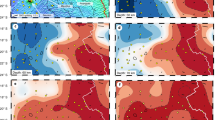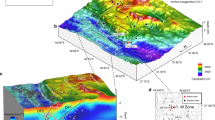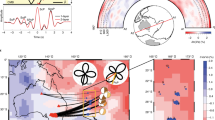Abstract
Hydrothermal circulation at the axis of mid-ocean ridges affects the chemistry of the lithosphere and overlying ocean, supports chemosynthetic biological communities and is responsible for significant heat transfer from the lithosphere to the ocean1,2,3. It is commonly thought that flow in these systems is oriented across the ridge axis, with recharge occurring along off-axis faults4,5,6, but the structure and scale of hydrothermal systems are usually inferred from thermal and geochemical models constrained by the geophysical setting7,8,9, rather than direct observations. The presence of microearthquakes may shed light on hydrothermal pathways by revealing zones of thermal cracking where cold sea water extracts heat from hot crustal rocks, as well as regions where magmatic and tectonic stresses create fractures that increase porosity and permeability. Here we show that hypocentres beneath a well-studied hydrothermal vent field on the East Pacific Rise cluster in a vertical pipe-like zone near a small axial discontinuity, and in a band that lies directly above the axial magma chamber. The location of the shallow pipe-like cluster relative to the distribution and temperature of hydrothermal vents along this section of the ridge suggests that hydrothermal recharge may be concentrated there as a consequence of the permeability generated by tectonic fracturing. Furthermore, we interpret the band of seismicity above the magma chamber as a zone of hydrothermal cracking, which suggests that hydrothermal circulation may be strongly aligned along the ridge axis. We conclude that models that suggest that hydrothermal cells are oriented across-axis, with diffuse off-axis recharge zones, may not apply to the fast-spreading East Pacific Rise.
This is a preview of subscription content, access via your institution
Access options
Subscribe to this journal
Receive 51 print issues and online access
$199.00 per year
only $3.90 per issue
Buy this article
- Purchase on Springer Link
- Instant access to full article PDF
Prices may be subject to local taxes which are calculated during checkout




Similar content being viewed by others
References
Slater, J. G., Jaupart, C. & Glason, D. The heat flow through oceanic and continental crust and the heat loss of the Earth. Rev. Geophys. Space Phys. 18, 269–311 (1980)
Stein, C. & Stein, S. Constraints on hydrothermal heat flux through the oceanic lithosphere from global heat flow. J. Geophys. Res. 99, 3081–3095 (1994)
Elderfield, H. & Schultz, A. Mid-ocean ridge hydrothermal fluxes and the chemical composition of the ocean. Annu. Rev. Earth Planet. Sci. 24, 191–224 (1996)
Lowell, R. P., Rona, P. A. & Von Herzen, R. P. Seafloor hydrothermal systems. J. Geophys. Res. 100, 327–352 (1995)
Kelley, D. S., Baross, J. A. & Delaney, J. R. Volcanoes, fluids and life at mid-ocean ridge spreading centers. Annu. Rev. Earth Planet. Sci. 30, 385–491 (2002)
Fisher, A. T. in Energy and Mass Transfer in Marine Hydrothermal Systems Vol. 3 (eds Halbach, P. E., Tunnicliffe, V. & Hein, J. R.) 29–52 (Dahlem Univ. Press, Berlin, 2003)
Johnson, H. P., Becker, K. & Von Herzen, R. Near-axis heat flow measurements on the northern Juan de Fuca Ridge: Implications for fluid circulation in oceanic crust. Geophys. Res. Lett. 20, 1875–1878 (1993)
Dunn, R. A., Toomey, D. R. & Solomon, S. C. Three-dimensional seismic structure and physical properties of the crust and shallow mantle beneath the East Pacific Rise at 9° 30′ N. J. Geophys. Res. 105, 23537–23555 (2000)
Lowell, R. P. & Yao, Y. Anhydrite precipitation and the extent of hydrothermal recharge zones at ocean ridge crests. J. Geophys. Res. 107 doi: 10.1029/2001JB001289 (2002)
Corliss, J. B. et al. Submarine thermal springs on the Galapagos rift. Science 203, 1073–1083 (1979)
Haymon, R. M. et al. Hydrothermal vent distribution along the East Pacific Rise crest (9°09′–54′ N) and its relationship to magmatic and tectonic processes on fast-spreading mid-ocean ridges. Earth Planet. Sci. Lett. 104, 513–534 (1991)
McDuff, R. E. in Seafloor Hydrothermal Systems (eds Humphris, S. E., Zierenberg, R. A., Mullineaux, L. S. & Thomson, R. E.) 357–368 (American Geophysical Union, Washington DC, 1995)
Haymon, R. M. et al. Volcanic eruption of the mid-ocean ridge along the East Pacific Rise crest at 9°45–52′ N: Direct submersible observations of seafloor phenomena associated with an eruption event in April, 1991. Earth Planet. Sci. Lett. 119, 85–101 (1993)
Rubin, K., Macdougall, J. D. & Perfit, M. R. 210Po–210Pb dating of recent volcanic eruptions on the sea floor. Nature 368, 841–844 (1994)
Tolstoy, M. et al. A seafloor spreading event captured by seismometers. Science 314 1920–1922 doi: 0.1126/science.1133950 (2006)
Kent, G. M., Harding, A. J. & Orcutt, J. A. Distribution of magma beneath the East Pacific Rise between the Clipperton Transform and the 9° 17′ N deval from forward modelling of common depth point data. J. Geophys. Res. 98, 13971–13995 (1993)
Bohnenstiehl, D. R. & Carbotte, S. Faulting patterns near 19°30′ S on the East Pacific Rise: Fault formation and growth at a superfast spreading center. Geochem. Geophys. Geosyst. 2 doi: 10.1029/2001GC000156 (2001)
Purdy, M., Kong, L. S. L., Christeson, G. L. & Solomon, S. C. Relation between spreading rate and the seismic structure of mid-ocean ridges. Nature 355, 815–817 (1992)
Floyd, J. S., Tolstoy, M. & Mutter, J. C. Seismotectonics of mid-ocean ridge propagation in Hess Deep. Science 298, 1765–1768 (2002)
Curewitz, D. & Karson, J. A. in Faulting and Magmatism at Mid-Ocean Ridges (eds Buck, W. R., Delaney, P. T., Karson, J. A. & Lagabrielle, Y.), Geophysical Monograph 106 117–136 (American Geophysical Union, Washington DC, 1998)
Scheirer, D. S., Shank, T. M. & Fornari, D. J. Temperature variations at diffuse and focused flow hydrothermal vent sites along the northern East Pacific Rise. Geochem. Geophys. Geosyst. 7 doi: 10.1029/2005GC001094 (2006)
Von Damm, K. L. in Mid-Ocean Ridges: Hydrothermal Interactions between the Lithosphere and Ocean Geophysical Monograph 148, 187–217 (American Geophysical Union, Washington DC, 2004)
Singh, S. C., Collier, J. S., Harding, A. J., Kent, G. M. & Orcutt, J. A. Seismic evidence for a hydrothermal layer above the solid roof of the axial magma chamber at the southern East Pacific Rise. Geology 27, 219–222 (1999)
Wilcock, W. S. D., Archer, S. D. & Purdy, G. M. Microearthquakes on the Endeavour segment of the Juan de Fuca Ridge. J. Geophys. Res. 107 doi: 10.1029/2001JB000505 (2002)
Tolstoy, M., Harding, A. J. & Orcutt, J. A. Deepening of the axial magma chamber toward the Garret Fracture Zone from multichannel data. J. Geophys. Res. 102, 3097–3108 (1997)
Von Damm, K. L. & Lilley, M. D. in The Subsurface Biosphere at Mid-Ocean Ridges Geophysical Monograph 144 245–268 (American Geophysical Union, Washington DC, 2004)
Ramondenc, P., Leonid, N. G. A., Von Damm, K. L. & Lowell, R. P. The first measurements of hydrothermal heat output at 9degrees 50′ N, East Pacific Rise. Earth Planet. Sci. Lett. 245, 487–497 (2006)
Klein, F. W. User's guide to HYPOINVERSE2000, a Fortran program to solve for earthquake locations and magnitudes. Open-file Report 02–171 (US Geological Survey, 2002)
Kissling, E., Ellsworth, W. L., Eberhartphillips, D. & Kradolfer, U. Initial reference models in local earthquake tomography. J. Geophys. Res. 99, 19635–19646 (1994)
Waldhauser, F. & Ellsworth, W. L. A double-difference earthquake location algorithm: Method and application to the Northern Hayward Fault, California. Bull. Seism. Soc. Am. 90, 1353–1368 (2000)
Vera, E. E. et al. The structure of 0- to 0.2-m.y.-old oceanic crust at 9° N on the East Pacific Rise from expanded spread profiles. J. Geophys. Res. 95, 15529–15556 (1990)
Harding, A. J., Kent, G. M. & Orcutt, J. A. A multichannel seismic investigation of upper crustal structure at 9° N on the East Pacific Rise: Implications for crustal accretion. J. Geophys. Res. 98, 13925–13944 (1993)
Waldhauser, F. HypoDD: A program to compute double-difference hypocenter locations. USGS Open-file Report 01–113 (US Geological Survey, Menlo Park, California, 2001)
Bakun, W. H. & Joyner, W. B. The M L scale in central California. Bull. Seism. Soc. Am. 74, 1827–1843 (1984)
Acknowledgements
M.T. thanks S. Carbotte for discussions. We thank the captain, crew and science party of the RV Keldysh and RV Atlantis. M.T. thanks J. Cameron, A. M. Sagalevitch, Disney and Walden Media for making initial OBS deployment possible. This work was supported by the NSF.
Author information
Authors and Affiliations
Corresponding author
Supplementary information
Supplementary Information
This file contains Supplementary Discussion; Supplementary Figures 1-7 with Legends and Supplementary Notes. The Supplementary Discussion contains one paragraph discussion of the temporal variability and temperature data shown in Supplementary Figures 4 and 5. The Supplementary Notes contain the grant number that supported the work, and the LDEO contribution number. (PDF 8924 kb)
Rights and permissions
About this article
Cite this article
Tolstoy, M., Waldhauser, F., Bohnenstiehl, D. et al. Seismic identification of along-axis hydrothermal flow on the East Pacific Rise. Nature 451, 181–184 (2008). https://doi.org/10.1038/nature06424
Received:
Accepted:
Issue Date:
DOI: https://doi.org/10.1038/nature06424
This article is cited by
-
Sulfide metallogenic model for the ultraslow-spreading Southwest Indian Ridge
Science China Earth Sciences (2023)
-
Diversity of magmatism, hydrothermal processes and microbial interactions at mid-ocean ridges
Nature Reviews Earth & Environment (2022)
-
Global variation of seismic energy release with oceanic lithosphere age
Scientific Reports (2021)
-
Platinum-group element geochemistry of the volcanic rocks associated with the Jaguar and Bentley Cu–Zn volcanogenic massive sulfide (VMS) deposits, Western Australia: implications for the role of chalcophile element fertility on VMS mineralization
Mineralium Deposita (2021)
-
The mechanism of tidal triggering of earthquakes at mid-ocean ridges
Nature Communications (2019)
Comments
By submitting a comment you agree to abide by our Terms and Community Guidelines. If you find something abusive or that does not comply with our terms or guidelines please flag it as inappropriate.



